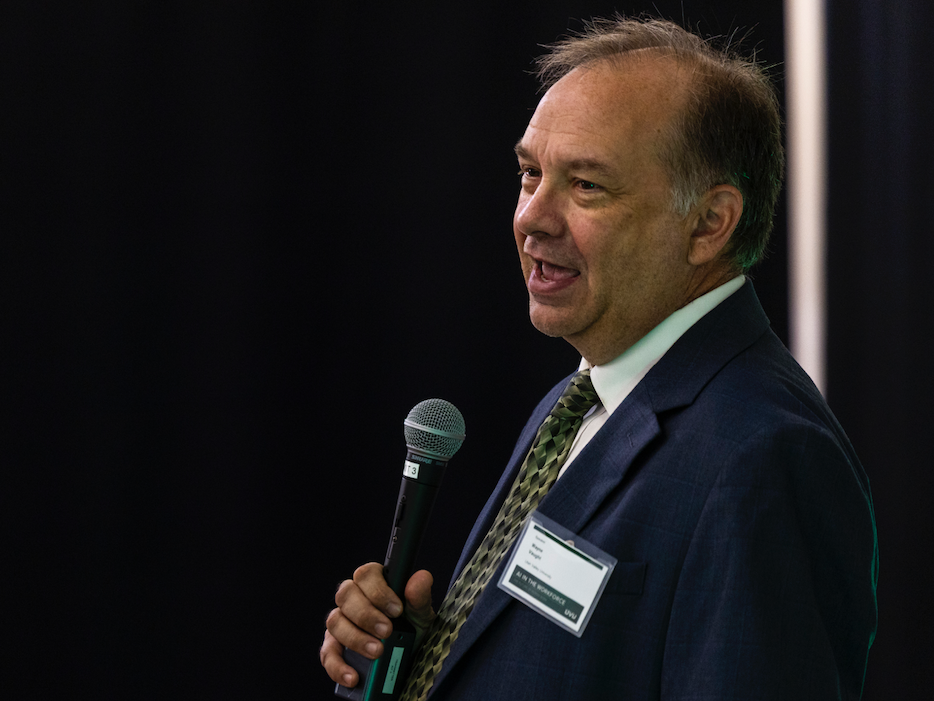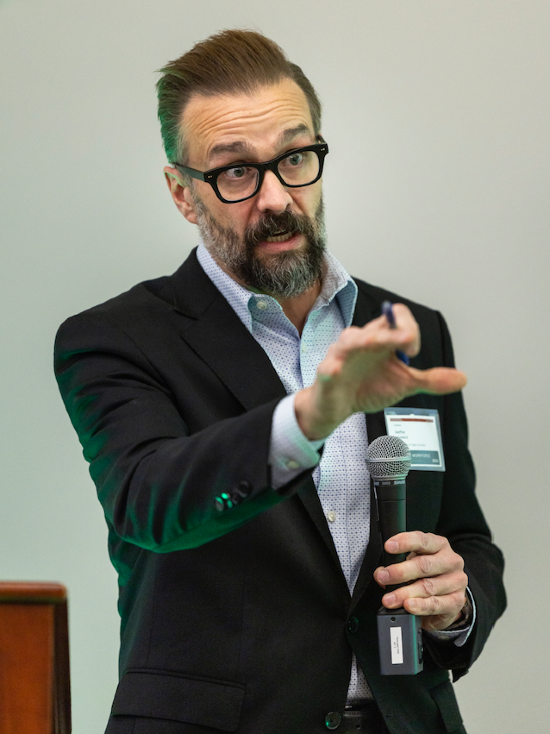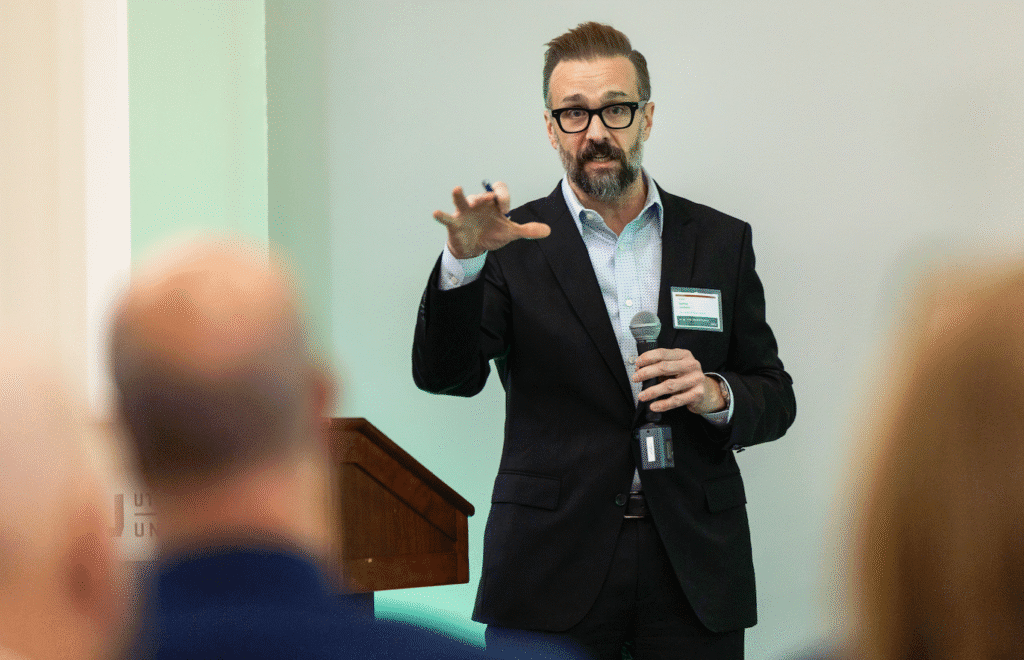Lehi, Utah — November 10, 2025
Utah’s universities, long pillars of higher education, now find themselves navigating uncharted terrain: an era in which artificial intelligence is not a distant possibility but an everyday force reshaping the workplace. At the November 7th AI in the Workforce: The Future of Human Work conference at Utah Valley University’s Lehi campus, Commissioner of Higher Education Geoffrey Landward laid out a vision for how the state’s colleges and universities can adapt — and not just survive, but thrive.

Landward began with humor, reflecting on his unusual profile bio that came up in the introduction, “I don’t like being a public figure. I don’t want the attention,” he admitted with humility and self-deprecating wit. “I kept putting it off writing it, but finally I was told I have to do this. So I wrote it facetiously. And then they just put it on the site, as written; it wasn’t what I intended, but it garnered so many comments, I thought, ‘It is true reflection of me, so why don’t we just stick with it.’” His light-hearted opening quickly gave way to urgency, as he framed the central challenge to the audience: preparing students for careers that are being redefined by AI, automation, and machine learning.
The data, he stressed, is stark. “Ninety percent of employers identify AI, machine learning, and automation as critical worker skills,” he said. “Sixty-seven percent of employers are adding jobs requiring AI skills. And there’s been an 84 percent increase in job postings requiring AI skills from 2023 to 2025. Forty-four percent of core workforce skills are expected to transform in the next five years.” In short, the workplace is changing faster than traditional education models can adapt.
The conference opened with contextual framing from UVU Provost Dr. F. Wayne Vaught, who traced the anxieties around technological revolutions throughout history. “From the printing press to the internet, professors feared their roles would disappear,” said Dr. Vaught. “It seems to always be the refrain. AI is no different.” Dr. Vaught emphasized that universities are not simply degree factories but community resources: “It’s our role as a university to prepare not just our students, but really the community. Those trained in AI technologies are going to be the ones that have the most impact. People who can use AI will replace those who can’t.”

For Landward, the path forward is clear: higher education must evolve beyond traditional models. “The model of higher education that has traditionally existed for centuries will not continue. It cannot continue in what’s coming,” he said. Universities must become agile institutions, continuously updating curricula, integrating applied AI across programs, and experimenting with new teaching methods.
Central to Landward’s vision is the idea that learning must move out of the classroom and into real-world contexts. He described partnerships between students, faculty, and industry in which AI tools are applied to solve actual problems. “Consider a Utah manufacturer partnering with one of our colleges to integrate AI tools in its production process. Students and faculty work side by side with industry experts to design smarter systems that reduce waste, increase precision, and improve profitability,” he explained. This approach, Landward argued, cultivates human skills that AI cannot replicate: mentorship, collaboration, problem-solving, and adaptability.

These themes surfaced repeatedly during the Q&A, where Landward emphasized that AI proficiency alone is not sufficient. “By the time we train for a specific technical skill, the water’s already moved under the bridge — and we’re back to refilling the cup,” he said. Technical skills are important, but the enduring competencies are human: teamwork, leadership, emotional intelligence, and the ability to learn, unlearn, and relearn at a rapid pace.
Landward also elaborated on his concept of an “experiential university,” a pilot institution where conventional norms are set aside in favor of innovation. “I’d like to have a university that we say, ‘This is going to be our sandbox university,’” he said. “A place where we throw out all the conventions — the way faculty function, the incentives we have for performance, and how students experience learning.”
In this model, students would use AI tools not as a subject of instruction but as instruments to solve real problems with guidance from faculty mentors and industry experts. Microcredentials would replace the proliferation of traditional degree programs, allowing learners to stack skills over time in response to evolving workforce demands. “Instead of 250 degree programs, maybe you have five,” Landward suggested, “and everything else is stackable microcredentials that you can come back and continue to build year after year.”
This approach also reinforces critical thinking, a skill Landward sees as essential in the AI era. “Facts are easy to learn,” he explained, “but critical thinking is knowing how to challenge them. It’s about asking the right questions, not memorizing the answers.” He cited his law school experience in the Socratic method as an example: students take positions, are challenged, and learn to analyze and question — a skill that translates directly into workplace problem-solving. Landward’s vision preserves the value of general education while explicitly linking classroom experiences to workforce applicability.

Throughout his remarks, Landward emphasized the moral responsibility of higher education in a human-centered AI era. “We have to ensure the power of AI enhances rather than replaces human creativity,” he said. The transformation, he noted, is not limited to students entering the workforce; it also includes incumbent workers who need ongoing upskilling. Utah’s universities are investing in short-term training, AI-aligned certificates, and regional education hubs to meet this demand.
Landward outlined several concrete initiatives already underway in Utah’s public higher education system:
- K–12 CTE pathways: Expanding AI-focused career technical education, including new courses and teacher endorsements, supported by a quarter-million-dollar investment.
- Higher education credentials: Creating and expanding AI-aligned certificates, apprenticeships, and degrees aligned with regional workforce demand, backed by a million-dollar investment.
- Student commercialization and research: Supporting the commercialization of AI technologies developed by students, fostering real-world impact with another quarter-million-dollar allocation.
- Emerging AI workforce training: Offering AI user credentials and bootcamps for upskilling incumbent workers, funded with a $2 million investment.
- Curriculum modernization: Investing a half-million dollars to expedite AI integration across programs aligned with targeted industry clusters.
“These investments are meaningful, but they are not nearly enough,” Landward acknowledged. “The pace of change requires us to do more — and to do it differently.”

Dr. Vaught’s remarks resonate here as well, underscoring the continuity of human engagement despite technological disruption. “AI is going to change the workforce, but it’s not going to change the fact that we need people engaged with each other, people meeting the needs of our community,” he said. “Universities need to provide opportunities for continuing education, training beyond degrees, and partnerships that ensure students and the community can thrive in this new landscape.”
Landward sees this evolution as both a challenge and an opportunity. The traditional four-year degree model may no longer suffice for a workforce that must adapt constantly. Instead, he advocates for flexible learning pathways, stackable credentials, and immersive experiences where students and industry collaborate to solve real problems. “We are providing opportunities for people to enrich their lives, open up economic opportunities, and achieve lifelong success,” he said. “We just need to do it differently.”
By emphasizing adaptability, mentorship, and experiential learning, Landward and Utah’s higher education system are positioning themselves to lead rather than follow in the AI era. “We don’t know all the answers yet,” he admitted, “but we do know that if we don’t innovate, we will be left behind. And that is not an option for our students, our workforce, or our state.”
Learn more at ushe.edu.

Share this article

